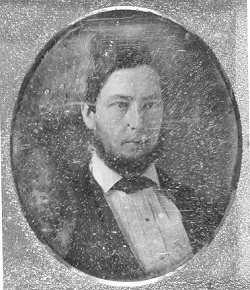Written by Tracy Melton '85.
 Edmund Mitchell, daguerreotype.
Edmund Mitchell, daguerreotype.
Recent donation of Tracy Melton ('85).Young Baltimore merchant Edmund Mitchell sat for a daguerreotype before October 10, 1850. We know this because in the earliest hour of that day, an assassin fired a pistol into the back of Mitchell’s right knee as he was stepping into a neighborhood tavern. The pistol load destroyed the joint and severed his femoral artery, blood flowing onto the tavern floor. Doctors amputated his leg, but he died that afternoon.
Mitchell and his friends were celebrating a Whig election victory. The victory had come after a particularly vicious campaign, which revealed partisan fractures that would soon result in the breakup of the Democratic-Whig party structure and the emergence in Baltimore of the American Party—the Know Nothings.
Mitchell’s assassination proved a harbinger of ten years of political violence. Scores would die in partisan fighting in Baltimore over the next decade—in riots, targeted assassinations, and street fights among the most notorious rowdies.
Mitchell was thirty-two and already a long-time Whig politician. In 1840, he had helped organize William Henry Harrison’s Tippecanoe campaign in Baltimore. Four years later, he served as secretary of the Central Clay Club—formed to support Henry Clay’s presidential campaign—and advertised its offer of rewards for convictions of anyone voting illegally or swearing falsely to obtain naturalization papers necessary for voting.
Mitchell was also president of the Vigilant Fire Company. The city’s volunteer fire companies served as important nexuses, bringing together local business people, politicians, and rowdies in formidable neighborhood organizations, often aligned with political parties.
That night, Democratic rowdies, including Thomas Moody, George Zimmerman, and Alexander Thompson, were at the tavern when Mitchell arrived. Most of Moody’s party were in an adjacent alley or exited the back of the tavern into the alley. Mitchell’s friends had already entered when the fatal shot felled him at the door. Referring to Moody’s crowd, a newspaper correspondent later wrote, “They all escaped trial by some legal quibbles, but their guilt was universally believed, and Zimmerman was the one on whom the circumstantial testimony fixed the firing of the fatal shot.”
The aftermath was also a harbinger. A month later, one of Mitchell’s friends shot and killed Moody at a theater barroom after a cry, “Who killed Ned Mitchell?” A year later, Zimmerman, a young prizefighter, was fatally stabbed during a street brawl, as he and his friends were trying to organize a prizefight. Thompson’s brother William H. “Country” Thompson, a larger-than-life Democratic rowdy, would also die in a political dispute. Violence begetting violence.
That daguerreotype of the young Baltimore merchant, the first victim of a bitter, homicidal political era, now resides in the Special Collections Research Center in Swem Library—a ghostly message from the past.
Tracy Matthew Melton ('85) is author of Hanging Henry Gambrill: The Violent Career of Baltimore's Plug Uglies, 1854-1860 and numerous articles on obscure but significant people and events in Baltimore and beyond.